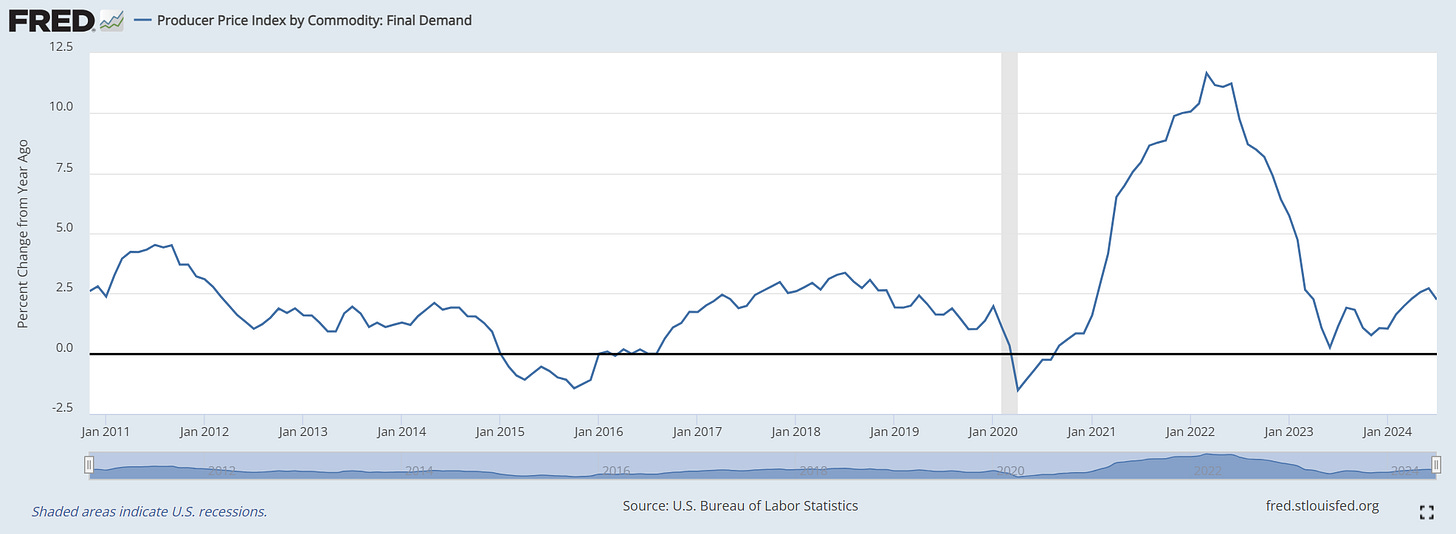PPI, CPI, and claims, oh my.
This was a big week for data. Tuesday saw the Producer Price Index release.
PPI final demand increased at 2.2% year-over-year. This came in under market expectations of 2.3% and below last month’s upwardly revised 2.7% gain.
Wednesday saw the Consumer Price Index come in at 2.9% year-over-year.
Shelter continues to buoy the CPI number. Motor Vehicle insurance (which is a lagging indicator) also surprised pundits with it’s continued strength.
It appears that many discretionary purchases are seeing slowdowns in this report. Household furnishings, new & used vehicles, and airfare continue to see downward pressure. This could mean that consumers are changing preferences away from these categories or it could be that they are running out of discretionary funds to spend. I think we are seeing this play out with the current earnings reports. Home Depot lamented the fact that the consumer was slowing down their purchases. However today, Walmart cheered the consumer stability and increased sales.
Either way, these are important data points for the higher for longer cheerleaders. The market’s reaction was quite muted to a sub-3% CPI print. This tells me that the market is much more focused on employment.
The last FOMC meeting and recent Fed speakers have hinted at the fact that the Fed’s mandate appears to be in better balance as inflation has come down. This means that the Fed is beginning to look closer at employment data and that means Mr. Market is going to be laser focused on jobs. We see this today with the employment claims data.
Initial jobless claims came in under consensus expectations (227k vs 235k). Meanwhile, continuing claims also came in under expectations (1864k vs 1880k). This provided a big boost to the market. Good news is good news, apparently. To the Fed, this should be seen as great news. We continue to see inflation moderating while employment data stays in the safe zone. This allows the Fed to take it slow.
I’m excited for the Jackson Hole Economic Symposium. This is an annual meeting that the Federal Reserve Bank of Kansas City puts on in Jackson Hole Wyoming. The theme for this year’s symposium is “Reassessing the Effectiveness and Transmission of Monetary Policy”. It will take place August 22nd through the 24th. I think we are going to hear how the Fed anticipates the remainder of the year to play out. I’m hopeful that we’ll see the Fed throw the Treasury under the bus for their reckless treasury auctions, buybacks, and yield curve distortions. A man can dream.
This week also saw action from the Treasury Dept. Monday was the release day for the US Treasury’s monthly statement. In it was the federal surplus/deficit.
The spending by the federal government continues to get out of hand. The above chart is modified to look at the data on an annual basis. Monthly data is too noisy to see the trend. We are treading in dangerous waters here. This week saw the Treasury issue 10-year, 3-year, and 30-year notes and bonds. The Treasury has very limited latitude when it comes to their recent auctions.
Jim Bianco tweeted on this earlier in the month.
Essentially what is happening is that the market’s appetite for US Treasury notes and bonds are current pricing is full. The Treasury is unable to auction more notes and bonds without dropping the price lower and thereby moving the yield higher. This would lead one to believe that if the Treasury didn’t engage in market shenanigans (overloading the market with Tbills and performing their own version of operation twist), we would have a normalized yield curve.











